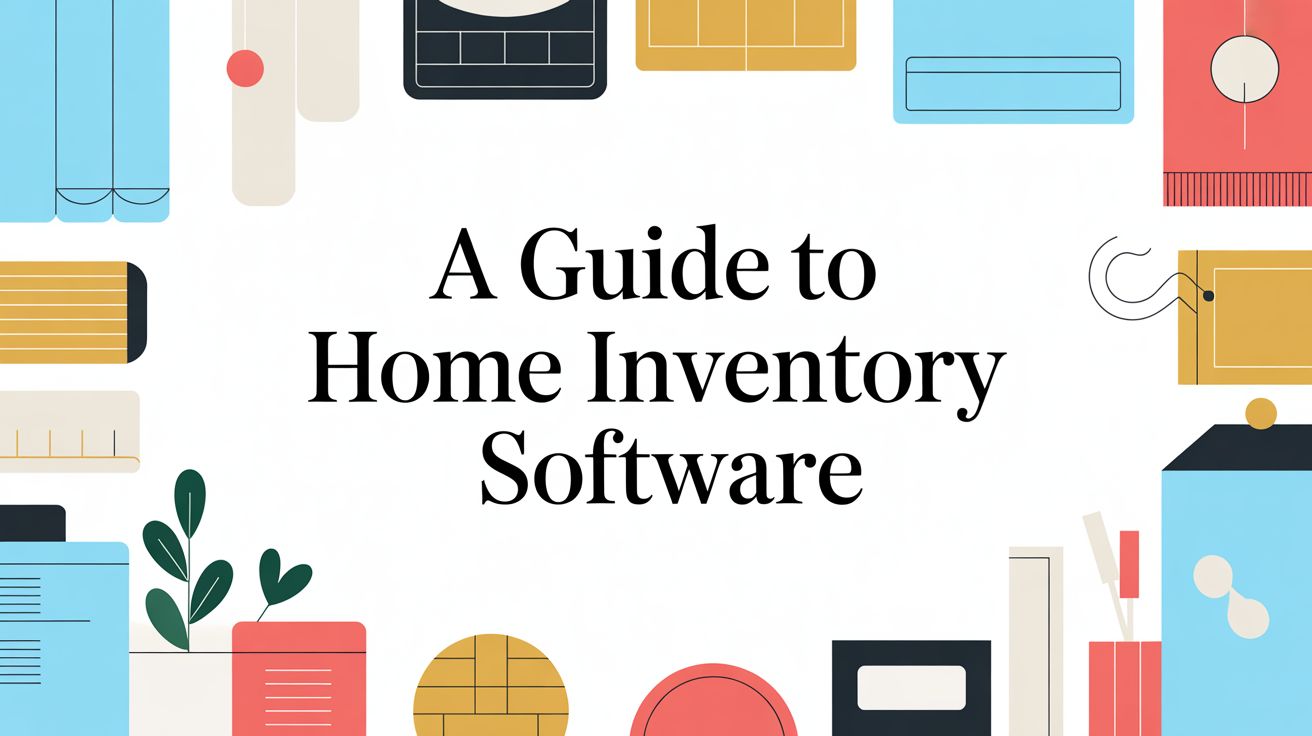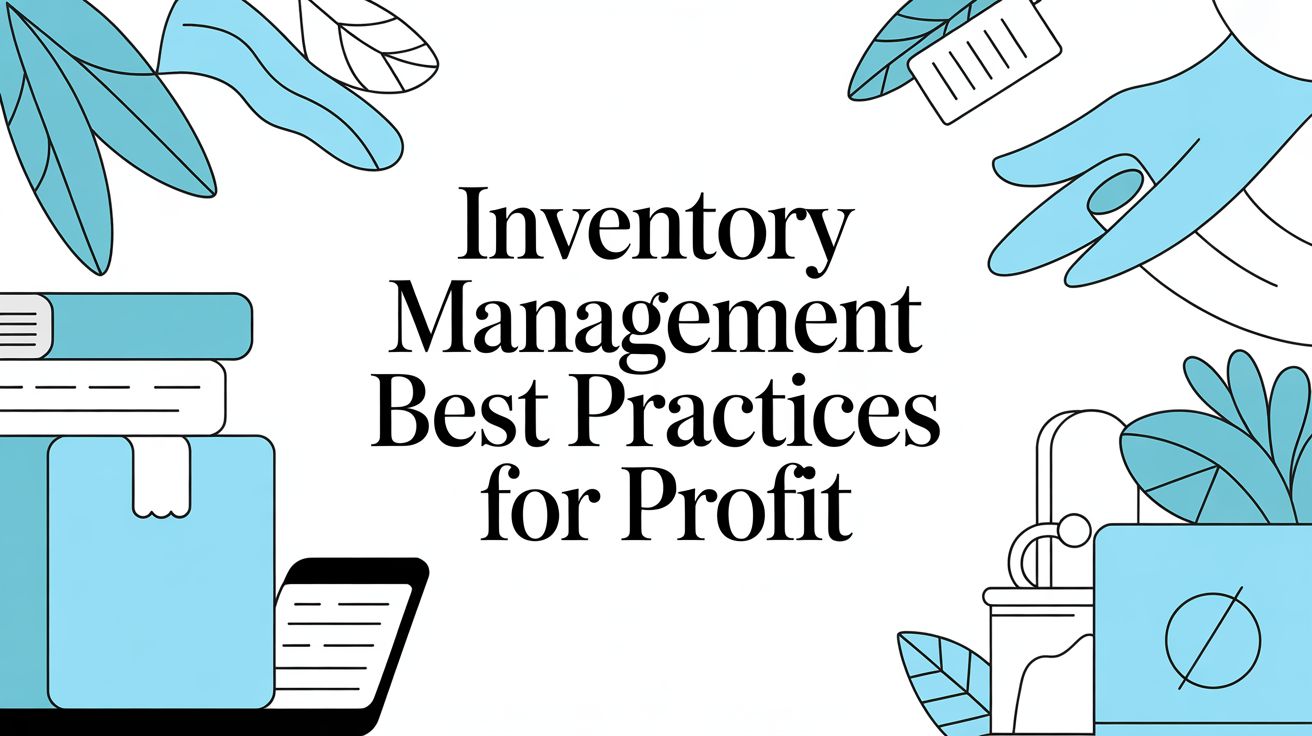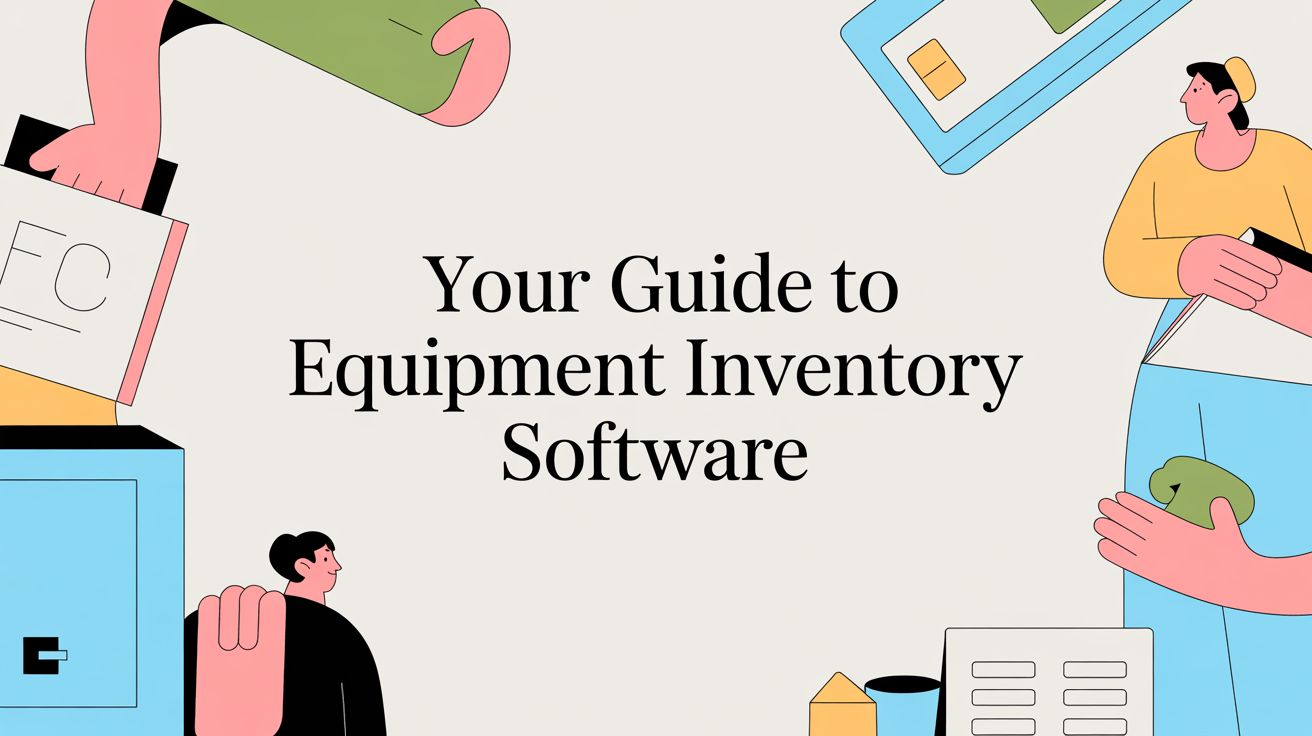Picture this: a fire, a flood, or a theft happens. The first thing your insurance company will ask for is a list of everything you lost. Now, try to remember every single item you own, from the big-screen TV down to that expensive blender in the back of the pantry. It’s an impossible, overwhelming task.
This is exactly the nightmare home inventory software is designed to prevent. It’s a digital vault for your belongings, a personal catalog of everything you own, including electronics, furniture, jewelry, and even those irreplaceable family heirlooms.
The Digital Librarian for Your Home
The best way to think about it is like having a dedicated digital librarian for all your possessions. Sure, you could use a simple spreadsheet to jot down a list of items, but that's just scratching the surface. This kind of software is built to organize, track, and protect the story of everything you own in one secure, easily accessible place.
Instead of a chaotic shoebox full of faded receipts and foggy memories, you get a clean, detailed record. And that record is your single most powerful tool when disaster strikes. Insurance companies need proof of ownership and value to process a claim fairly. A well-kept inventory gives them exactly that, providing photos, purchase dates, receipts, and serial numbers, all neatly organized. That simple step can be the difference between a fair settlement and a devastating financial loss.
Beyond Basic Spreadsheets
A spreadsheet is a flat, static list. Home inventory software, on the other hand, is a living, dynamic system. It lets you do things a simple list just can't:
- Attach Visual Proof: Snap photos, take quick videos, or scan receipts and upload them directly to an item's entry.
- Organize Intuitively: Sort your stuff by room, category, value, or purchase date. Find what you need in seconds, not hours.
- Generate Reports: With just a few clicks, you can create professional, detailed reports perfect for insurance adjusters, estate planners, or even just for your own records.
This screenshot shows the kind of basic list that forms the foundation of any cataloging system.

But modern software takes this simple concept and supercharges it with features that make the whole process faster, easier, and much more secure.
A Growing Need for Digital Asset Management
More and more, people are realizing that digitally organizing their physical world isn't a luxury; it's a necessity. This shift is obvious when you look at the numbers. The global market for home inventory apps is projected to more than double, growing from USD 2.18 billion to over USD 5.0 billion by 2035.
This isn't just a tech trend; it shows a fundamental change in how homeowners are thinking about financial security and peace of mind. You can learn more about these home inventory apps market trends to see how technology is reshaping home management. What was once a daunting, manual chore has become a simple, empowering process that truly safeguards your most valuable assets.
Why a Digital Inventory Is a Financial Safety Net
Beyond just keeping things tidy, a digital catalog of your possessions is one of the smartest financial moves you can make. Think of it less as a chore and more as a proactive investment in your financial security. When disaster strikes, this detailed record becomes your single most powerful tool for recovery.
The real value shines through in a crisis. After a fire, flood, or theft, your insurance company is going to ask for a complete list of everything that was lost or damaged. Trying to create that list from memory, especially while you’re reeling from the shock, is a recipe for forgotten items and a much smaller settlement.
A digital inventory with photos, purchase dates, and receipts removes all the guesswork. It’s undeniable proof of ownership and value, which can dramatically speed up the claims process and ensure you get fair compensation for what you've lost. You can find out more by reading our detailed guide on using a home inventory for insurance claims.
Speeding Up Insurance Claims
Let’s imagine a real-world scenario. Two families on the same street have their ground floors flooded after a severe storm. The first family, with no inventory, spends agonizing weeks trying to recall every single lost item, from the TV to the antique armchair to the kids' gaming consoles. Their claim drags on, bogged down by disputes and missing proof.
The second family, however, had used home inventory software. Within hours of the event, they generated a detailed PDF report complete with photos, serial numbers, and scanned receipts for their most valuable items. Their insurance adjuster had clear, verifiable proof, and their claim was settled quickly and fairly, allowing them to start rebuilding their lives that much faster.
A detailed inventory isn't just for major disasters. It’s an essential tool for any insurance claim, big or small, providing the proof you need to secure the full value you're entitled to.
Comparing Inventory Methods
It’s easy to see why dedicated software outshines old-school methods. A simple spreadsheet just can't keep up.
| Feature | Manual Inventory (Spreadsheet/Notebook) | Home Inventory Software |
|---|---|---|
| Data Entry | Tedious, 100% manual input | Fast, often automated with photo recognition (like Vorby's AI) |
| Visual Proof | Difficult to link photos and files | Photos and documents are attached directly to each item |
| Accessibility | Can be lost in a disaster if stored locally | Cloud-based, accessible from anywhere on any device |
| Reporting | Requires manual creation of lists | Generates detailed, professional reports with one click |
| Searchability | Clunky and limited (Ctrl+F) | Powerful search filters by room, category, value, or color |
| Security | Only as secure as your computer | Encrypted and backed up professionally |
While a manual list is better than nothing, software is designed from the ground up to make the process efficient, secure, and incredibly useful when you need it most.
Simplifying Estate Planning
A digital inventory also plays a crucial role in estate planning. When it’s time to pass on your assets, a clear, comprehensive record ensures your wishes are carried out exactly as you intended. It helps prevent confusion and potential conflicts among family members by providing a transparent account of all your valuable possessions.
This kind of clarity is a gift to the executor of your estate. They can easily identify, locate, and distribute assets according to your will, making an incredibly difficult process smoother for everyone involved. Without it, precious heirlooms can be overlooked and assets misidentified, leading to both emotional and financial complications. By cataloging everything beforehand, you provide a clear roadmap for your legacy, protecting your assets and your loved ones.
Key Features of Effective Home Inventory Software
Not all home inventory tools are created equal. When you start looking, it’s easy to get lost in a sea of apps that are little more than glorified digital checklists. To find something that offers real protection and convenience, you have to look past the basics and focus on features that actually deliver value.
These core functions are what separate a simple list-making app from a powerful asset management system that can truly safeguard your belongings when you need it most.
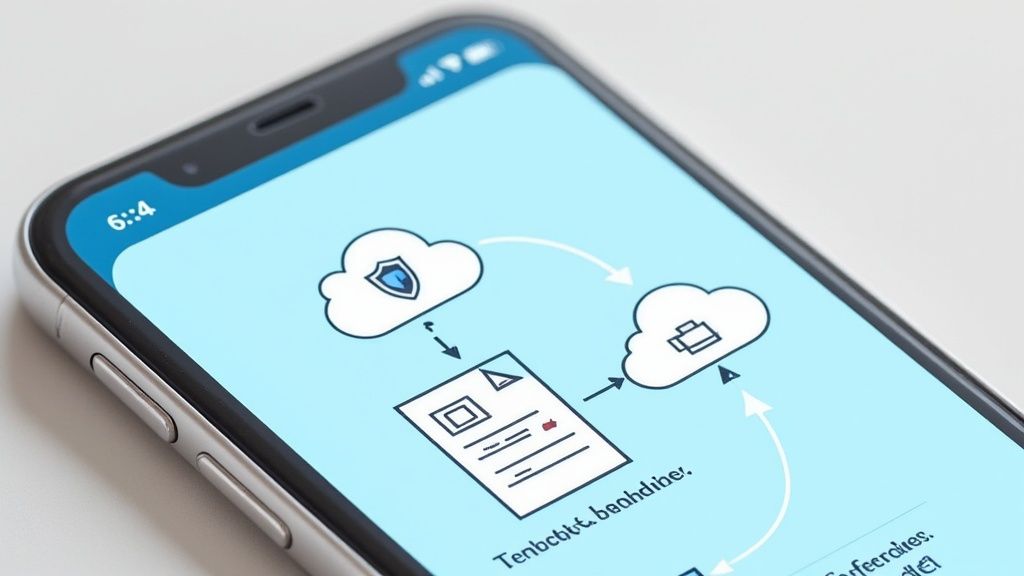
The best home inventory software should feel less like a digital notebook and more like a dedicated personal assistant. It needs to be intuitive, secure, and ready to go whether you're planning a move or facing an unexpected emergency.
Foundational Must-Haves for Any System
Before you get wowed by fancy bells and whistles, make sure any platform you're considering absolutely nails the fundamentals. These are the non-negotiables that form the backbone of any reliable inventory system.
- Unlimited Item Entries: Your collection of belongings will grow over time. You should never hit a wall because of an arbitrary cap on how many items you can add.
- Secure Cloud Storage: This is critical. Your inventory data, including photos and receipts, must be stored securely in the cloud. This keeps it safe from local disasters (like a fire that destroys your laptop) and makes it accessible from any device, anywhere.
- Robust Categorization and Search: What good is an inventory if you can't find anything? You need the ability to locate any item in seconds. Look for flexible tagging, organization by room, and a powerful search function.
- Detailed Reporting: In a crisis, clear documentation is everything. A key feature is the ability to export your entire inventory (or just specific parts) into a clean, detailed PDF report for insurance adjusters, estate planners, or law enforcement.
These foundational features ensure your inventory isn't just comprehensive, but genuinely useful. Without them, even the most advanced app will fall short.
The rise of smartphones and tablets has made these tools more accessible than ever, fueling a surge in adoption. Features like AI-powered image recognition and seamless sharing have only boosted their appeal. You can explore more on the rise of home inventory apps to see how technology is reshaping home management.
Modern Capabilities That Save Time and Effort
The most effective modern platforms go way beyond simple data entry. They use technology to automate the tedious parts and give you deeper insights into what you own.
One of the biggest game-changers is AI-powered item recognition. Instead of you having to manually type in the brand, model, and category for every single thing, platforms like Vorby use AI to identify items automatically from the photos you upload. Snap a picture of your new TV, and the AI does the heavy lifting, saving you countless hours of mind-numbing work.
Another absolute must-have is a dedicated mobile app. The ability to just walk through your house with your smartphone, adding items as you go, is essential. It lets you capture photos, scan barcodes, and update details on the spot. This makes the inventory process feel like a natural part of your routine rather than a huge project you have to schedule. That convenience is the key to keeping your inventory accurate and up to date over the long haul.
Practical Uses for Your Home Inventory
While preparing for the worst is a smart reason to create a home inventory, its real value shows up in everyday life. Think of your digital catalog less like a fire extinguisher, something you hope you never need, and more like a master key for your entire home. It’s a dynamic tool that simplifies some of life's most common (and stressful) events.
From planning a cross-country move to managing day-to-day repairs, your inventory can become the command center for your household. Let's dig into a few situations where this simple tool proves its worth time and time again.
Streamlining Your Next Move
Moving is chaos. We all know it. It's a tornado of boxes, packing tape, and that nagging feeling you’ve forgotten something important. An up-to-date inventory is your secret weapon against the stress. It’s your master checklist, giving you a complete, room-by-room list of everything you own before a single box gets packed.
As you start packing, you can simply update each item’s status in your app, noting which box it’s in. This tiny step saves you from tearing open ten boxes just to find the coffee maker on your first morning. And if a mover drops your favorite lamp? You’ve got clear, dated photos from before the move, making that insurance claim airtight and hassle-free. For a structured plan, our home inventory checklist is a great place to start.
Simplifying Estate Planning
Organizing your assets for estate planning is one of the kindest things you can do for your loved ones. A detailed home inventory brings incredible clarity to an otherwise emotional and confusing process, heading off potential disputes before they even start.
It gives the executor of your estate a clear, itemized list of your physical possessions, from your vinyl collection to your grandmother's wedding ring. This ensures everything is accounted for and distributed exactly as you intended. This digital record acts as a transparent guide, making a difficult time just a little bit smoother for everyone involved.
A complete inventory transforms abstract wishes into a concrete, actionable plan. It provides a clear roadmap for your legacy, ensuring your possessions are handled with the care and intention you desire.
Managing Home Maintenance and Repairs
Your inventory can also double as a central hub for home maintenance. Instead of frantically digging through that one chaotic drawer for a user manual or a warranty receipt, you can attach them directly to the appliance's entry in your software.
Think about the possibilities:
- Warranty Tracking: Log the purchase date and warranty expiration for your dishwasher, refrigerator, or TV. Get a reminder before it runs out.
- Repair History: Keep notes on past service calls, including dates, what was fixed, and the technician’s contact info.
- Project Details: Store paint codes, flooring types, and other materials you used in home improvement projects. No more guessing games at the hardware store.
Suddenly, your inventory isn't just a list of stuff; it’s a powerful maintenance log. It’s proactive home management, made incredibly simple.
How to Choose the Right Software for Your Needs
With so many options on the market, trying to find the right home inventory software can feel a bit overwhelming. The secret is to tune out the flashy marketing and zero in on what you actually need it to do. A tool that’s perfect for cataloging a small apartment probably won’t cut it for managing a large estate packed with valuable collections.
The whole process starts with one simple question: what’s your primary goal? Are you getting organized mainly for insurance preparedness, trying to simplify a big move, or mapping things out for long-term estate planning? Your answer will immediately clarify your priorities.
This decision tree gives you a great visual of how different life events all point back to the core reasons for having a home inventory.
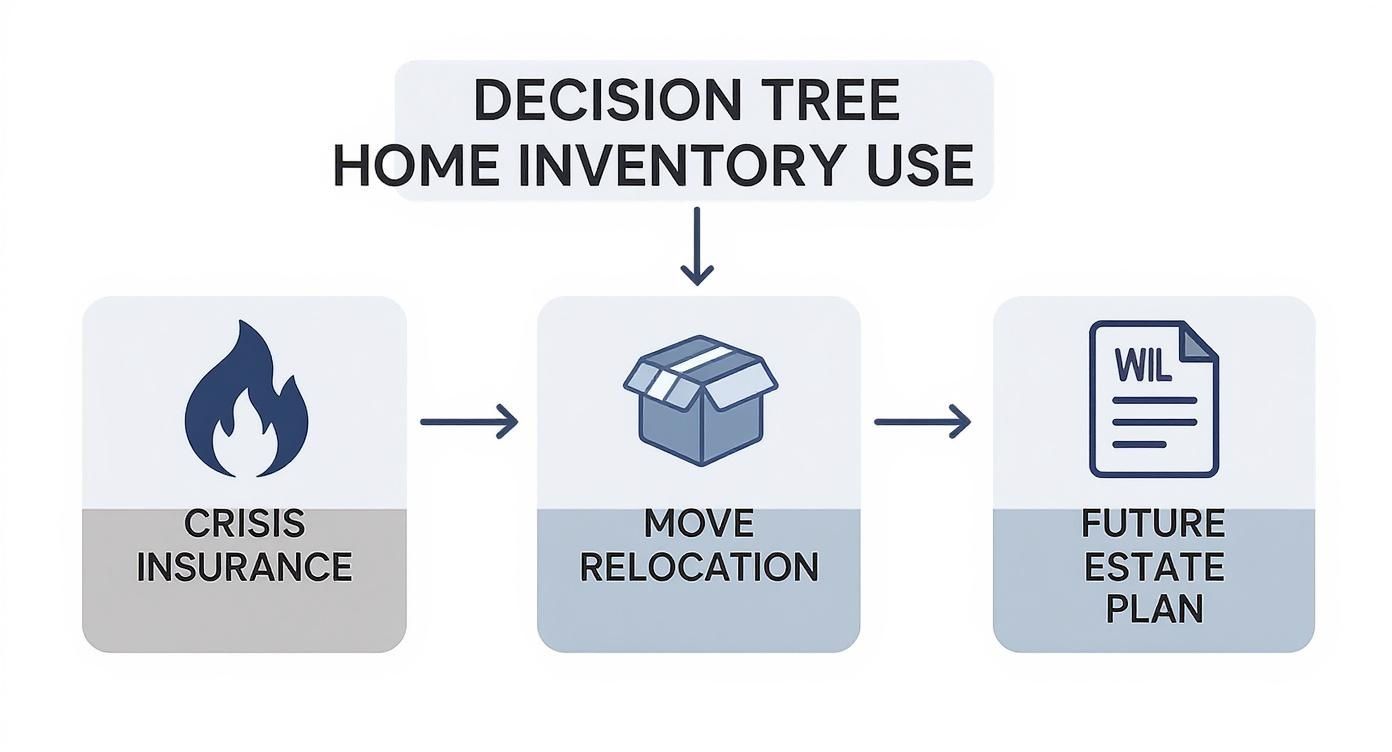
As you can see, it doesn't matter if you're dealing with a crisis, planning a move, or thinking about the future, because a detailed inventory is the common thread that gives you control and peace of mind.
Evaluating Core Functionality and Usability
Once you've nailed down your main objective, you can start comparing software on the features that truly matter. A clean, intuitive user interface is completely non-negotiable. If the software is clunky or confusing to navigate, you’re simply not going to keep your inventory updated, and that defeats the whole purpose.
Look for a solution that makes the process feel effortless. For instance, a platform like Vorby uses AI-powered item recognition to automatically identify your belongings from photos, saving you countless hours of tedious manual data entry. You can learn more about making this process painless by reading our complete guide on finding the perfect inventory tracker app for your home.
Security Protocols and Data Portability
Let's be clear: you're cataloging sensitive personal information, so security has to be a top priority. Your data should be protected with strong encryption, both when it's stored on servers (at rest) and when it's being transmitted (in transit). Always take a few minutes to review a provider’s security policies before you sign up.
Just as important is data exportability. You should have the ability to download your entire inventory, including photos and documents, at any time. This ensures you’re never locked into a single service and that your data always remains yours to control.
Choosing the right software means finding a balance between powerful features and genuine ease of use. The best tool is one that integrates smoothly into your life, making asset protection a simple, ongoing habit rather than a massive, one-time project.
Understanding Pricing and Support
Home inventory software generally falls into two pricing models: a one-time purchase or an ongoing subscription. Subscriptions often come with the benefit of continuous updates, secure cloud storage, and customer support, which can be invaluable. Compare the costs against the features you get to see what offers the best long-term value for your situation.
The quality of customer support is another factor you shouldn't overlook. If you run into a problem, you’ll want access to responsive and genuinely helpful assistance. Check for options like email support, live chat, or a detailed knowledge base. A solid support system is a great sign that a company is invested in its users' success, which usually points to a high-quality and reliable service. The demand for these tools is growing fast, especially in North America, which holds the largest market share thanks to high digital adoption rates and a rising awareness of asset management. You can discover more about the home inventory apps market to understand these trends.
Common Questions About Home Inventory Software
Jumping into any new piece of software can feel a little daunting. You’ve got questions, and getting clear, straightforward answers is the best way to feel confident you’re making the right move to protect your home and everything in it. Let’s tackle some of the most common queries we hear.
This process should feel empowering, not confusing. Having the right information helps you move forward with total peace of mind.
Is My Personal Data Secure with This Software?
This is usually the first question people ask, and for good reason. The short answer is yes, as long as you choose a reputable service. Leading home inventory platforms use heavy-duty security measures like end-to-end encryption to shield your information. Think of it as sending your data through a scrambled, digital tunnel that only you and the service can unlock.
Top-tier platforms like Vorby are built on strict, industry-standard security protocols to keep your personal details and inventory safe from prying eyes. It's always a smart habit to glance over any service's privacy policy, just so you know exactly how your data is being handled.
How Long Does It Take to Create an Inventory?
This is the big one that stops most people before they even start. The time it takes obviously depends on the size of your home and how much stuff you have, but it’s a much more manageable project than you might think. You absolutely do not have to do it all in one weekend.
The best strategy? Tackle it one room at a time, and focus on your most valuable items first.
Modern software with AI-powered image recognition has completely changed the game, dramatically cutting down on manual entry. By dedicating just 20 to 30 minutes a day, most people can create a detailed inventory for an average-sized home within a couple of weeks.
Is a Spreadsheet Good Enough?
Look, using a spreadsheet is definitely better than having no inventory at all. But it’s like using a flip phone in a smartphone world; it works, but you're missing out on features that make life infinitely easier. Spreadsheets make it incredibly difficult to attach photos, videos, and receipts directly to specific items, which is the most critical part of an insurance claim.
Plus, they don’t have user-friendly mobile apps for quick updates on the go, and they can’t generate the professional, detailed reports that insurance adjusters need. Dedicated home inventory software provides a secure, structured, and far more efficient way to manage everything when it matters most.
What Information Should I Record for Each Item?
To make your inventory truly useful, you need to capture a few key details for each item. A complete entry is your best friend during an insurance claim and gives you a perfect record for your own reference.
Aim to capture these details:
- The item's name and a quick description.
- Several clear photos from different angles.
- The original purchase date and price.
- The brand, model number, and serial number (if you can find it).
- A digital copy of the receipt or appraisal document.
The more thorough you are, the more powerful your inventory becomes.
Ready to see how simple this can be? Vorby uses powerful AI to make cataloging your home fast, easy, and secure. Start your free 14-day trial today and experience what real peace of mind feels like.
